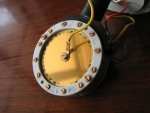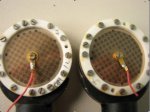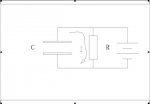In a condenser microphone, the most important part is the capsule which works as a capacitor to convert acoustical energy into electrical energy. In the capsule, the diaphragm acts as one plate of a capacitor, and the vibrations caused by sound wave produce changes in the distance between the plates and therefore change the capacitance. .
Let’s have a close look at the most important part of a condenser microphone------the capsule, what does it look like?
In the picture below is one capsule, nice and clean. This type of capsule is called center-terminated capsule, you can see that the electric contact point is in the center of the diaphragm.
Let’s have a close look at the most important part of a condenser microphone------the capsule, what does it look like?
In the picture below is one capsule, nice and clean. This type of capsule is called center-terminated capsule, you can see that the electric contact point is in the center of the diaphragm.







 just some guy who feels to share some of my experiences with everyone here and hope to learn more from you.
just some guy who feels to share some of my experiences with everyone here and hope to learn more from you.
